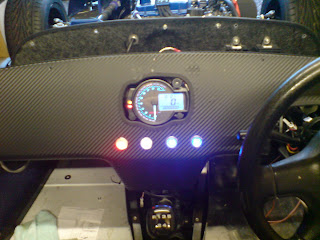After researching where best to position the digidash, there seemed to be three main options
1) Behind the steering wheel
2) Middle of the dash but recessed so the surface is flush
3) Within the IVA exclusion zone around the steering wheel
I dismissed the first idea as I couldn't see an easy way to mount the digidash plus the wires to the rear would be exposed. I then dismissed option three as this would mean cutting a hole free hand and I wasn't convinced I'd make a tidy job of it so I opted for the third method.
Using masking tape and a square, I marked out the steering wheel radius and then marked another radius 127mm out. Then, whilst sitting in the drivers seat marked a position to mount the digidash making sure I could see the speedo panel. The dremel was used to make a square shaped hole for the loom connector and three more holes to allow the digidash to sit against the dashboard. After mounting the digidash using the supplied screws the dashboard was then offered up to the scuttle. At this point, I realised I
could see the speed reading but - only through my left eye! The steering wheel rim blocked the view when looking through my right eye. Feeling rather annoyed I did what was probably best and sulk off for a beer and to sleep on it.

The next morning, I'd decided I should have gone for option 2 from the beginning. The holes I'd made the previous evening were filled with araldite, the dash wrapped with di-noc and a hole cut. Some U trim was applied to the hole to neaten the edges and an aluminium bracket made up to support the digidash. With this in place, I set to wiring up the savage switches with three multi connector plugs to allow for easy connection and removal if required. I'd used some sikaflex to attach some cable tie bases to the back of the dash so that the wires do not hang down.

How digidash is mounted now:

The savage switches from left to right are low brake fluid /test, side lights, fog light switch and fan over-ride switch.
I also needed to extend the speedo cable and water temp cables to connect to the Koso dash. Most of the wiring is now done apart from the front lights and a general tidy up underneath the scuttle.
=====================
To whoever it was that asked about the speedo sensor - I fixed a magnet to one of the drive shafts and using a bracket then pointed the Koso sensor at the magnet. I did reply to your query/comment on this blog but it wouldn't publish my reply (I tried twice! - don't know whats happened to blogspot but its been a pain in the backside to use recently)
